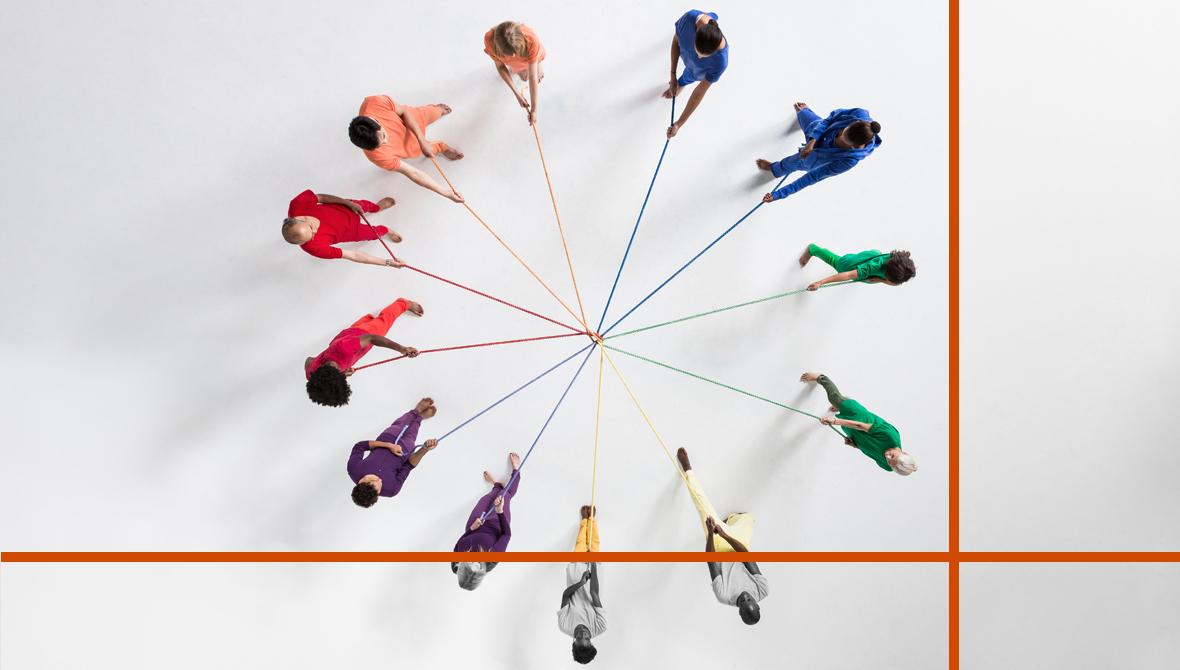The power of generosity in ecosystems
A well-orchestrated network of businesses that look out for one another creates greater value in difficult times.

Generosity has played a fundamental role in the survival of many species, including our own. Research shows that humans are hardwired to be generous—the benefits of collaboration outweigh those of competition. In business, where the rise of ecosystems is changing the way companies are thinking and talking about competition, there’s plenty of evidence that long-term collaboration with partners can bring more benefit than traditional firm-to-firm competition, spurring innovation in particular. What initially were formed as supply chain relationships, partnerships, or alliances have evolved into complex business dependencies. The question now is whether more generous-minded collaboration would further enhance value creation.
Not surprisingly, generosity has become a hot topic in the business-strategist community. That’s not to say business ecosystems cannot do well without generosity-based collaboration—many do—but the point is that companies could be missing out on the potential impact generosity can have on improving the competitive advantage of organizations in these ecosystems. There’s some evidence to suggest generous ecosystems have an edge. The proof of this may come down to careful planning.
The University of Notre Dame’s Science of Generosity initiative defines the concept as “the virtue of giving good things to others freely and abundantly.” Generosity asks that resources such as attention, time, and availability (including emotional) are accessible and open-handedly offered. The idea was put to the test by a team from the Macquarie Business School in Sydney, Australia, who interviewed nearly 800 managers working in ecosystems in Sydney and Silicon Valley and found that generous systems—those that shared information and resources more openly—generated significantly more competitive advantage (measured by degrees of innovativeness, efficiency, quality, and responsiveness) than those that didn’t. The authors noted that generosity smooths human relations and avoids the downfall of our selfish, competitive nature. Their analysis suggests that being generous—or giving resources to ecosystem partners—accounted for more than twice the explained variance in competitive advantage than just taking resources from business partners.
I coordinate a group of 70 chief strategy officers who are part of the Outthinker Strategy Network; and our members, including billion-dollar public companies as well as smaller organizations, are keenly debating the role of competition and cooperation, and how generosity might be integrated into ecosystem design. As member Adam Zalisk, senior vice president of corporate strategy at Amplify, an education technology company based in New York, says, “Generosity can be as powerful a tool as direct strategic competition, when we define generosity as a sharing value among all the players in an ecosystem to best serve end-users—in our case, educators and students.”
Amplify has long worked to create thriving K–12 ecosystems through collaboration and sharing with a wide variety of partners. Many of Amplify’s products are anchored in partnerships with leading academic research institutions. The company builds on those institutions’ research with the design, technology, implementation, and distribution capabilities needed to bring their insights to life in classrooms. Additionally, Amplify and its partners frequently make components of their programs free to K–12 schools; these open resources support students, educators, and communities while also creating more opportunities for the ecosystem to learn from educator and student feedback, speeding improvement of Amplify’s products.
Companies could be missing out on the potential impact generosity can have on improving the competitive advantage of organizations in business ecosystems.
The resulting ecosystem brings better solutions to students and educators than any player could do on its own. By identifying value and a unique role for each member of the ecosystem, all stakeholders generate greater social and commercial results than they otherwise would. “Generosity is the power that keeps the ecosystem together,” Zalisk says.
Shifting mindsets
A traditional approach to competition, rooted in the business mindset of one company gaining an advantage over another, can make it difficult to play in an ecosystem as a participant. For example, one of the risks of being part of an ecosystem is the dependency on its orchestrator. Increased reliance on Big Tech and the consolidation of many industries have created an increased risk of a few powerful cash-generator businesses that need to reward shareholders with consistent, attractive margins and will not think twice about burdening their partners to keep those margins—for example, by asking for discounts in exchange for participating in the ecosystem.
But what if there was more of a sense of mutual collaboration? Benjamin Gomes-Casseres of Brandeis University has published research with Harvard Business Review Press on different business combinations (his term for business ecosystems). He states that for an ecosystem to logically exist, the players within an ecosystem must fairly share the benefits, creating added value for the entire ecosystem that exceeds the level of value each company could create independently.
It’s fair to say that even in my organization, not everyone is yet convinced. But for those considering a more generous approach to business collaborations, here are four issues to consider.
Purpose. By purpose, in this context, I mean a clear challenge or opportunity that can better be tackled by an ecosystem than by a single company. For most for-profit organizations, that would be focusing on what matters to the customer and then deciding which partners are best suited to improve customer experience, fulfill a need, or fix a major issue. A clear, agreed-upon purpose has direct correlation with collaboration and trust, as it supports relational agreements that are difficult to describe in real workplace or partnership contracts.
For example, a group of pharmacists in the Netherlands wanted to solve a problem of high-cost prescription medications developed for specific clients. A large percentage of these medications were not used by the clients and needed to be discarded, increasing the cost of the system and cost for the clients—and, in many cases, preventing patients at other pharmacies from having access to these medications. With the clear purpose of solving this problem, the pharmacist group developed Pharmaswap, a platform-based ecosystem in which pharmacists, until then competitors, could share with one another excess stocks of unused prescription medications, increasing the efficiency of the system and accessibility for customers.
Flexible boundaries. Generosity is at the core of cooperation—putting the needs of others first develops trust and bonds. Consequently, designing an ecosystem based on generosity, with flexible boundaries that promote dynamic networks between participants, can potentially work as a “generosity machine.”
Dynamic networks are based on the premise that human interactions are not random but driven by the perceived quality and reciprocity of a relationship. The logic is simple: the connection between generous cooperators has a more fruitful and stable relationship than a connection involving an ungenerous partner, or “defector,” and therefore is more effective. This essentially means being able to quickly identify who are the cooperators in the ecosystem and who are the defectors. Successful players update their networks frequently and dynamically, breaking links with defectors and forming new links with cooperators.
For example, one of our members is a sizable technology company that asks its most collaborative employees to work with its ecosystem partners because it believes this will accelerate the connectivity between the companies, helping to nurture the areas in which the collaboration is working and updating processes where it is not. This tech company has found that these efforts add to the success of its joint R&D, go-to-market, and logistic efforts, and also help to reduce inefficiencies and increase the speed of innovation. If boundaries are too strict and static, the emergence of a dynamic relationship among partners would be blocked.
Tracking generosity. It is challenging to measure generosity in ecosystems with thousands of players. Some key metrics are essential, including whether participants are extracting their fair share of the benefits of the ecosystem. The case of Haier, a global home appliances and electronics company, is interesting. Haier chairman emeritus, Zhang Ruimin, recently explained how the company developed a “win-win value added” statement to monitor the impact of its business in the ecosystem, which traditional financial statements don’t cover. One of the key goals of Haier’s statement is to codify, and thus understand, how the company works and evolves with its ecosystem partners—an intentional and generous way to track how every participant is benefiting from the ecosystem.
Microsoft takes an ecosystem management approach to interact with its 300,000 partners that are the channel for 95% of the company’s commercial sales. According to Satya Nadella, Microsoft’s CEO, “One of the things I want to design in our core is…what is the partner opportunity?” Microsoft monitors the success of the partners in its ecosystem and what kind of support they need to thrive.
Governance. A decision-making governance framework can help protect partners from unnecessary competition if generosity is built in specifically to nurture the sustainable delivery of purpose. During the successful collaboration in 2000 between Aventis (today Novartis) and Millennium Pharmaceutical (acquired by Takeda in 2008) that resulted in dozens of new drugs, both companies jointly created a list of behavior protocols focused on nurturing collaboration that was constantly monitored by both companies. Although some are what one would expect from companies partnering on a project—for instance, agreeing to jointly escalate problems—others clearly speak to the need for generosity. For example, both companies agreed “to share information regarding internal strategic business environment changes, so we can discuss their potential impact on the alliance.” And: “We will share with one another complaints we hear from internal constituents with the understanding that a) we are not defending or accusing but sharing information, b) we agree that we will jointly decide when something is significant enough to take action, c) we will collect data together about the situation, analyze and draw joint conclusions, and develop jointly any actions or plans in response to the problem.”
Introducing generosity as part of an ecosystem requires collaborators to address up front the issue of purpose and organizational design. They also must find ways to track the ecosystem’s health, beyond that of any one business. Generosity may still not be used as an organizational tool as much as its potential suggests it should—at least for now—but it is climbing up the strategist’s agenda.



